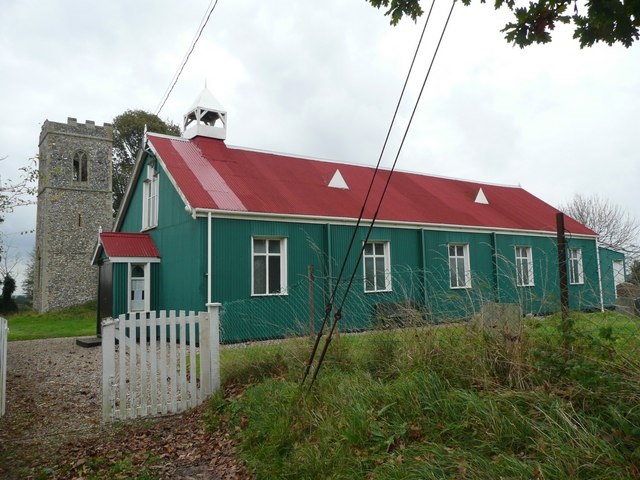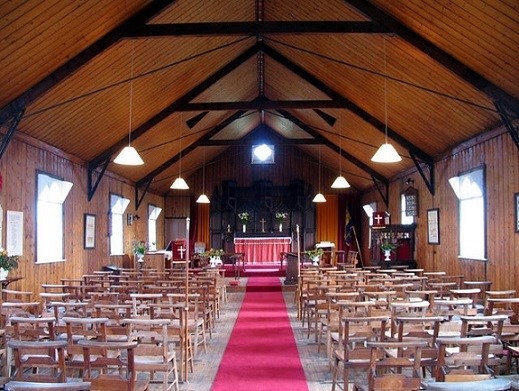
Burgh Parva has been closely intertwined with Melton Constable from earliest times. The name Burgh Parva is derived from Burgh, the Anglo-Saxon word for fort and Parva the Latin for small, although there is some suggestion that the name was derived from the River Bure, as Briston was.
There are no records about either the building or consecration of St Mary’s, Burgh Parva, but the first rector was Jeffrey de Burgh, presumably a local man, who was presented by Stephen de Astlee in 1317. At the time the church was part of the Bishopric of Norwich’s lordship of Melton. A list of the incumbents, with dates, hangs in the present day church.
In 1504, there was a gift of £100 to build a steeple and in 1552, there is a record of 2 bells in this steeple. 20 communicants where recorded as being present on Easter Day in 1603, and a gift of a communion table cloth was made by Lady Bridget Astley in 1659.
The register was closed in 1668, when the church ceased to be used and the rectory of Burgh Parva was consolidated with Melton Constable. The reasons for the closure are not entirely clear, the church may have been sacked by Cromwellian forces during the Civil War, when Walsingham was, or it might have been a plague village, or the numbers may have dwindled to a point where it was no longer viable. It may have been a combination of factors. All that remains of the village today is the hall built in 1573 and the ruins of the church.
Hanging in the corrugated iron church, is a print by Ladbroke of about 1823, showing the ruins of St Mary’s looking much as it does today, with the tower and part of the walls of the nave and chancel still standing. An existing pen and pencil drawing by R. England, of Binham, dated 19th January 1838, again shows the church looking very similar to today, although in both pictures, the tower is clearly damaged at the top and without the castellation.
In 1841, Sir Jacob Astley assumed the title of Baron Hastings. At about this time, a grand north wing, with marvelous views to the sea, was added to Burgh Parva Hall (also known as Burgh Hall). When this occurred, the church tower of St Mary’s was refurbished and castellations added, to enhance that view.
By 1994, the tower was beginning to show serious deterioration, particularly near the top when it had been struck by lightning some five years previously. Recently, thanks to a grant, the tower and remaining walls have been made safe and the deterioration halted.

At the beginning of 1881, there were 118 inhabitants in the parish of Melton Constable with Burgh Parva. Later that year, a new ‘town’ was created in an area of empty land on the borders of the parishes of Melton Constable and Briston, and in the following year, the Lynn and Fakenham Railway was extended eastwards to the new town. The railway was continued onto Norwich and subsequently the Yarmouth/Stalham light railway came in from the east and the Holt/Melton line from the north to form the railway crossroads of North Norfolk.
Thus, there was a requirement for a church to cater for this railway town and a competition was organized to design a new church to be built in the churchyard of St Mary’s. Over 60 plans were submitted from as far afield as London and Cardiff, but as Arthur Lacey, the architect and surveyor for the diocese recorded in his report of 9th May 1901, the result of the competition was not altogether satisfactory since ‘none of the competitors having fairly grasped the conditions, the majority of the schemes being too extravagant, and the few plans that are economical are poor and unworthy of your consideration.’ Several of these designs incorporated the old church, and three drawings from one of the entries is to be found in the existing church.
As a result, a temporary building, made of corrugated iron, was erected on the site in early 1903 and is still used today, with the original corrugated iron sheets. It was constructed by J. Rolfe and Co from London, at a cost of £272, 12 shillings and sixpence, including three Tortoise Slow Combustion Stoves. The construction was described as “One corrugated iron Church Hall 60 feet, by 25 feet, by 10 feet high to the eaves, with porch 6 feet by 4 feet and vestry 8 feet by 25 feet.” The foundations, steps, gates, bells etc. were built by W. Fisher of Hempton, Norfolk at a cost of £34 and 7 shillings. The new church was consecrated on Lady Day (25 March) 1903.

The altar reredos, which was installed in 1950/51, came from the church of St Philips in Norwich, after the latter was bombed and lost its tower during the war. In February 1976, the building was badly damaged by a freak whirlwind, but the only sign of this today is the war memorial, which was split in two.
The original church of St Mary’s was never deconsecrated.
You are looking for a bison. Please bring your own pen. There are a couple of places where you can pull off the road and park, but please take care if you have children with you as there is no pavement and the road can be busy.
**************************************
For full information on how you can expand the Church Micro series by sadexploration please read the Place your own Church Micro page before you contact him at churchmicro@gmail.com.
See also the Church Micro Statistics and Home pages for further information about the series.
*************************************